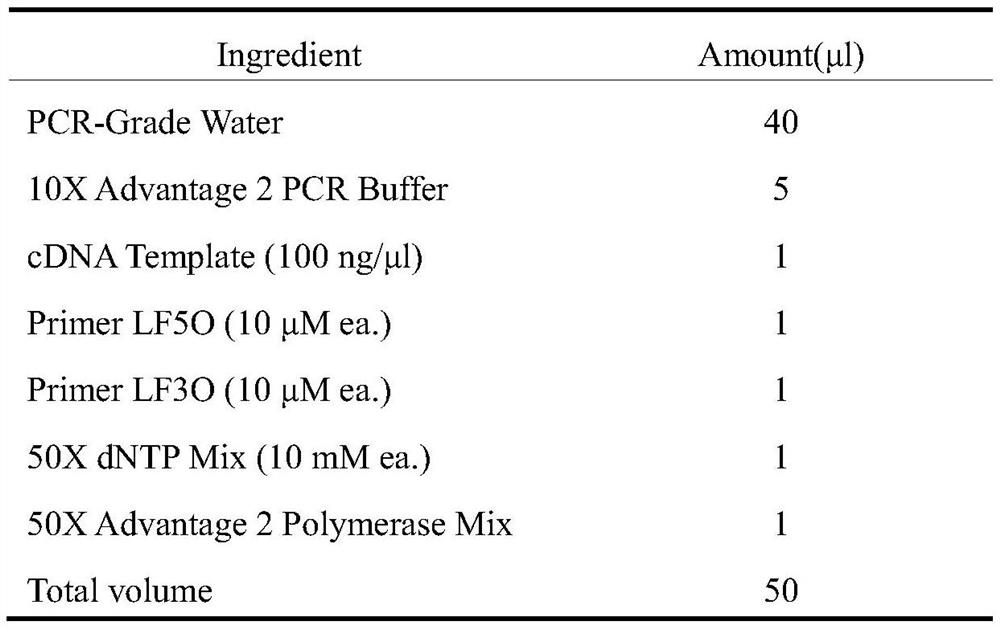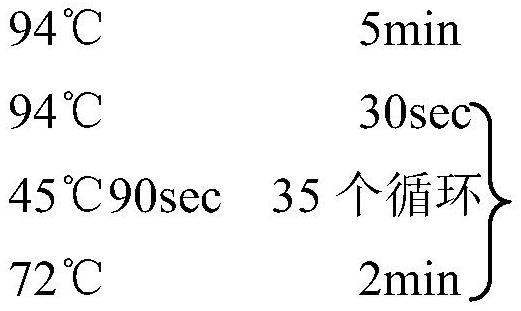Banana SSUII gene, cloning method, expression vector and application
A technology of gene expression and cloning method, which is applied in the field of regulation of banana carotenoid synthesis, and can solve problems such as lack of carotenoid content
- Summary
- Abstract
- Description
- Claims
- Application Information
AI Technical Summary
Problems solved by technology
Method used
Image
Examples
Embodiment 1
[0044] Example 1: Cloning method of banana gene
[0045] 1. Extraction of total RNA:
[0046] (1) Dispense 1 mL of CTAB extract into 2 mL centrifuge tubes and preheat at 65°C;
[0047] (2) Weigh 0.2 g of the material, grind it in liquid nitrogen, and immediately transfer it to a centrifuge tube containing CTAB extract, vortex to mix, and incubate at 65°C for 2 to 3 minutes;
[0048] (3) Immediately add an equal volume of chloroform / isoamyl alcohol (24:1), vortex to mix, and centrifuge at 10,000 rpm for 15 min at room temperature;
[0049] (4) Aspirate the supernatant into a new centrifuge tube and repeat step (3);
[0050] (5) Take the supernatant into a new centrifuge tube, add 1 / 3 volume of 8M LiCl, and precipitate overnight at 4°C;
[0051] (6) 4 ℃, 10000rpm centrifugation for 30min;
[0052] (7) discard the supernatant, wash the precipitate with 70% ethanol, and then wash with absolute ethanol;
[0053] (8) Dissolve the precipitate in 100 μl STE (preheated at 65°C), and...
Embodiment 2
[0064] Example 2: Real-time fluorescence quantitative RT-PCR expression detection of banana SSUII gene in different genotypes of banana
[0065] RNA was extracted from AAA, BB and TTT banana leaves, and cDNA was reverse transcribed. The cDNA templates of each genotype were analyzed by real-time quantitative PCR using real-time fluorescence quantitative PCR. Specific primers were designed according to the principle of qPCR primer design, and the internal reference gene was banana Musa actin. The primer sequences are as follows:
[0066]
[0067] Using SYBR Green I as a fluorescent dye, the relative expression levels of SSUII gene in different genotypes of bananas were determined by qPCR, using 2 -ΔΔCt The relative expression of SSUII gene in each sample was calculated by the method. React in QuantStudio TM 3 Real-time PCR instrument (Thermo Fisher Scientific). The reaction system was 20 μL (template 2 μL, forward and reverse primers 0.4 μL each, 50×ROX Reference Dye2 dye...
Embodiment 3
[0068] Embodiment 3: Construction of banana SSUII gene plant expression vector pBI121 1. Design primers according to the nucleotide sequence of the isolated banana SSUII gene:
[0069] Forward primer:
[0070] 5'-CGGGGGACGAGCTCGGTACCCCCAATCGTCTTCTTTATCG-3'
[0071] Reverse primer:
[0072] 5'-ACCATGGTGTCGACTCTAGAACTCAGCCATCAGTCAACCT-3'
[0073] The polymerase chain reaction was performed using the 5'Race cDNA reverse transcribed from total RNA as a template.
[0074] 2. Take 5 μl of PCR product and ligate it with pEASY-Blunt vector. The operation steps are carried out according to the instructions of Trans's product pEASY-BluntCloningKit. Escherichia coli DH5α strain was then transformed, and the surface was coated with isopropylthio-β-D-galactoside (IPTG) and 5-bromo-4-chloro-3-indole-β-D-galactoside (X-gal) ) on LB plates containing ampicillin (100 μg / ml) overnight. Pick white colonies and grow overnight in LB liquid medium. Plasmid DNA was extracted by alkaline method...
PUM
 Login to View More
Login to View More Abstract
Description
Claims
Application Information
 Login to View More
Login to View More - R&D
- Intellectual Property
- Life Sciences
- Materials
- Tech Scout
- Unparalleled Data Quality
- Higher Quality Content
- 60% Fewer Hallucinations
Browse by: Latest US Patents, China's latest patents, Technical Efficacy Thesaurus, Application Domain, Technology Topic, Popular Technical Reports.
© 2025 PatSnap. All rights reserved.Legal|Privacy policy|Modern Slavery Act Transparency Statement|Sitemap|About US| Contact US: help@patsnap.com



